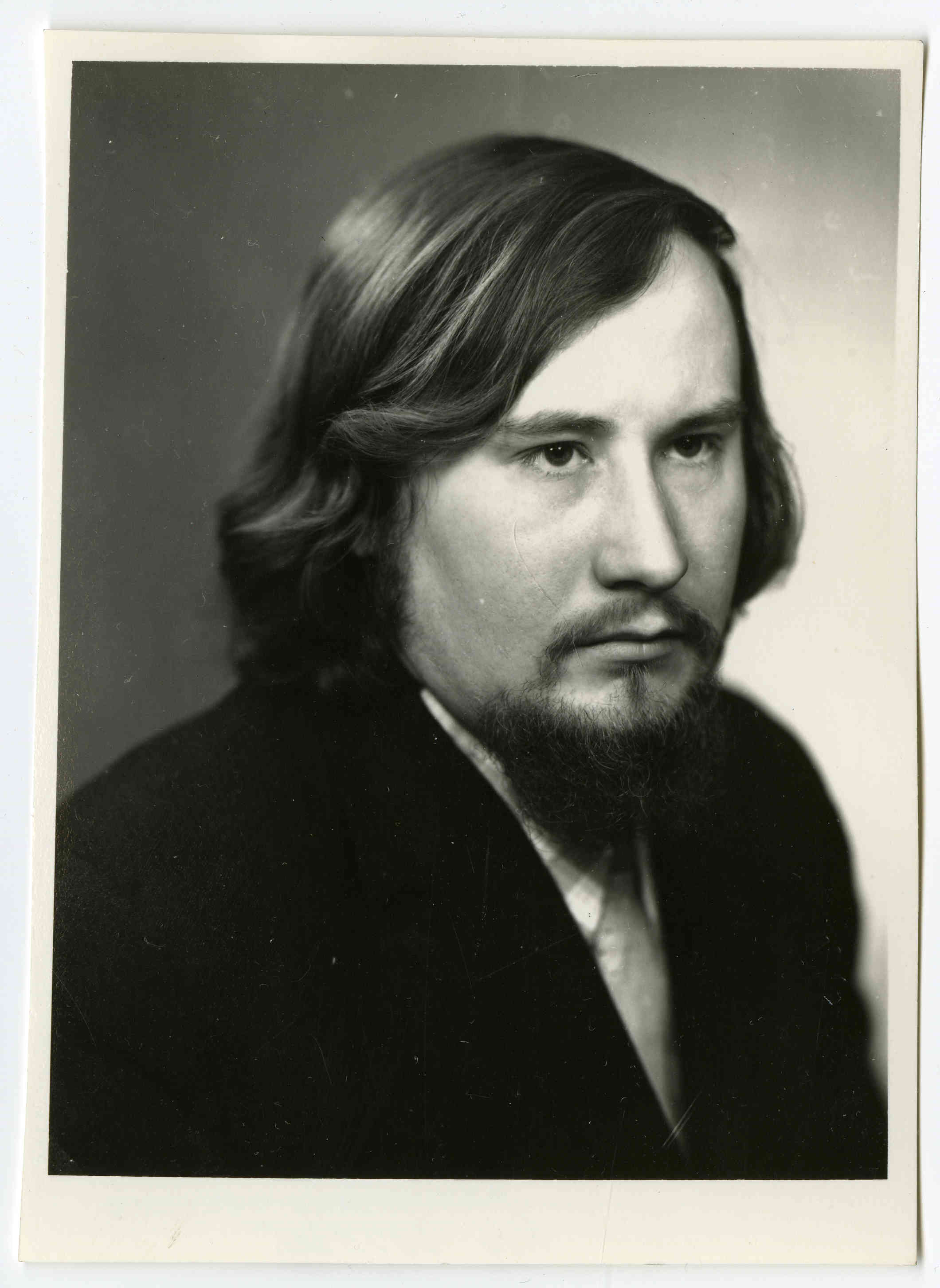
Kalju Saaber
Kalju Saaber (b. 11. X 1944) is a prose writer and playwright, children’s author and commentator.
Saaber was born in Inju-Aruvälja village, Küti parish, Viru county. He attended Paide and Rakvere secondary school, and then worked as a furniture-maker at the Rakvere timber combine, and graduated in 1963 from number 1 secondary school for working youths, Rakvere. From 1964 to 1967 Saaber studied history at Tartu State University. His studies were cut short when he contracted tuberculosis. Since 1968 Kalju Saaber has been a professional writer. He has been a member of the Writers’ Union since 1979. Saaber lives in Rakvere.
Saaber made his debut in 1965 with a story in the journal Noorus called Kilde mööbesepa päevikust (‘Slivers from the Diary of a Furniture-maker’), and thereafter he published several stories and tales in publications. The best of them were gathered in his first collection Romeo, Julia ja õhuhäire (‘Romeo, Juliet and the Air-raid Alarm’). There followed several collections and tales, as well as the novel Raske vesi (‘Heavy Water’). On the basis of the story Mustlased (‘The Gypsies’), a short film, Tätoveering (‘The Tattoo’) was made by the Tallinnfilm studios (1977, director Peeter Simm; the artistic supervisor of the film was Andrey Tarkovsky). Saaber’s earlier prose work is full of symbolism and influences from other writers. The locations of the works are often exotic, and the style is theatrically image-laden. The author concentrates on turning points in young people’s personal development.
In his more recent work Saaber’s style has become more realistic. He has depicted life in the villages of Virumaa in the difficult post-war period and the formation of kolkhoz collectives. In the novel Härgamisi (‘Slow as an Ox’, 1980), the focus is on the tragic fate of man of peasant values caught up in the historic events of the forties. For this book Saaber won the Eduard Vilde literature award in 1981. Saaber’s play Virumaa leib (‘Virumaa Bread’, staged in 1980) gives a panoramic view of village life in the decades after the war. With the play Kontvõõrad (‘Uninvited Guests’, staged in 1987) the author reacted to the danger of creating phosphorite mines. In the novel Punaselageda saaga (‘The Saga of Red Plains’), which was based on documentary material, Kalju Saaber was devoted to tracing the fates of Estonian farmers who migrated to Siberia and the Caucasus in the 19th century. The work won him the 1991 Virumaa literature prize and the 1992 Eduard Vilde literature award.
Saaber has also written children’s stories, poems, humorous sketches, cultural criticism and travelogues, as well as documentary film scripts. He compiled the anthology Virumaast ja virulastest (‘About Virumaa and Its People’) as well as the collection Virumaa (1996). His articles about local history are collected in Virumaa, me hingepigi: marginalia (‘Virumaa, Tar of Our Souls: Side Notes’, 1998). The volume Rakvere lugemik (‘The Rakvere Reader’, 2002), prepared for the 700th anniversary of the town of Rakvere, is a chronicle of the town in essay form, a compilation of meditations on significant events, places and people for the town.
In 2007 Kalju Saaber was awarded the badge of the Crown of Rakvere.
Saaber’s novel Härgamisi has appeared in Russian. His short prose and children’s stories have appeared in a dozen languages.
L. P. (Translated by C. M.)
Books in Estonian
Novels
Raske vesi. Tallinn: Eesti Raamat, 1976. 224 lk.
Härgamisi. Tallinn: Eesti Raamat, 1980. 232 lk.
Puulane ja Tohtlane. Ühe perenaise saaga. Tallinn: Eesti Raamat, 1983. 303 lk.
Hiiehobune. Tallinn: Eesti Raamat, 1989. 254 lk.
Punaselageda saaga. Tallinn: Eesti Raamat, 1991. 479 lk.
Luukere Atu. Tallinn: Avita, 2001. 253 lk.
Kohtume Islandi väraval. Tallinn: Eesti Raamat, 2013. 206 lk.
Sõidud Luukase ja Keesuga. Tallinn: Eesti Raamat, 2015. 269 lk.
Short prose
Romeo, Julia ja õhuhäire. Tallinn: Eesti Raamat, 1972. 296 lk.
Hellase kõrb. Tallinn: Eesti Raamat, 1975. 182 lk.
Mees, naine ja bernhardiin. Tallinn: Perioodika, 1978. 37 lk.
Meri: impressioon. Tallinn: Eesti Raamat, 1978. 196 lk.
Kahe kodu ballaad. Tallinn: Eesti Raamat, 1980. 192 lk.
Prantsuse kingad; Virumaa leib. Tallinn: Eesti Raamat, 1986. 164 lk. [Jutte ja näidend.]
Haruldast tõugu issi. Tallinn: Varrak, 2004. 198 lk.
Meister tegi, hästi tegi. Tallinn: TEA Kirjastus, 2007. 109 lk.
Issanda loomaaed. Viru sektor. Tallinn: Eesti Raamat, 2007. 357 lk. [Jutte ja näidend.]
Plays
Prantsuse kingad; Virumaa leib. Tallinn: Eesti Raamat, 1986. 164 lk. [Jutte ja näidend.]
Issanda loomaaed. Viru sektor. Tallinn: Eesti Raamat, 2007. 357 lk. [Jutte ja näidend.]
Children’s books
Nille, Värten ja Peopesa. Tallinn: Eesti Raamat, 1981. 79 lk.
On. Tallinn: Eesti Raamat, 1984. 18 lk.
Saurusesuvi. Pärnu: Perona, 1993. 183 lk.
Lepatriinu asfaldil. Tallinn: TEA Kirjastus, 2007. 142 lk.
Palju väikseid virmalisi. Tallinn: TEA Kirjastus, 2007. 114 lk.
Sipelgad ja suvitajad. Tallinn: Eesti Raamat, 2017. 157 lk.
Vanatädi valged elevandid. Tallinn: Eesti Raamat, 2019. 191 lk.
Non-fiction
Kaimude raamat. Publitsistikat ja reisikirju 1974–1980 [1. osa]. Tallinn: Eesti Raamat, 1982. 159 lk.
Kaimude raamat. Publitsistikat ja reisikirju 1979–1985 [2. osa]. Tallinn: Eesti Raamat, 1982. 253 lk.
Virumaa, me hingepigi: marginaalia. Rakvere: Lääne-Viru Maavalitsus, 1998. 96 lk.
Rakvere lugemik: linnakodanikele passieast vanaduseni. Rakvere: Tänapäev, 2002. 180 lk.



